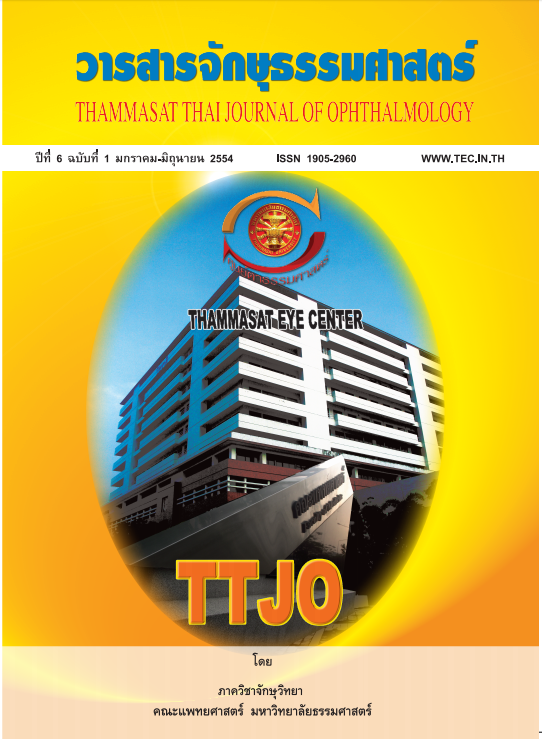ผลการรักษาผ่าตัดจอตาหลุดลอกด้วยวิธี pneumatic retinopexy ในโรงพยาบาลธรรมศาสตร์เฉลิมพระเกียรติ
Main Article Content
Abstract
วัตถุประสงค์ :เพื่อศึกษาผลการรักษาผ่าตัดจอตาหลุดลอกด้วยวิธี pneumatic retinopexy ในโรงพยาบาลธรรมศาสตร์ เฉลิมพระเกียรติ และปัจจัยซึ่งมีผลต่อผลสำเร็จของ การรักษาผ่าตัดจอตาหลุดลอกด้วยวิธี pneumatic retinopexy
รูปแบบการศึกษา: การวิจัยแบบย้อนหลัง
วิธีการศึกษา: ทำการศึกษาแบบย้อนหลัง โดยการ ทบทวนเวชระเบียนผู้ป่วยจอตาหลุดลอกที่มีรูฉีกขาด เข้ากับเกณฑ์ที่กำหนด ระหว่าง 1 มิถุนายน 2548 ถึง 31 พฤษภาคม 2553
ผลการศึกษา: ผู้ป่วยเป็นเพศชายร้อยละ 51.11 เป็น เพศหญิงร้อยละ 48.88 มีอายุเฉลี่ย 53 ปี ประสบผลสำเร็จ ในการผ่าตัดในแง่การติดกลับของจอตาที่ 1 สัปดาห์ 1 เดือน 2 เดือน และ 3 เดือนหลังการผ่าตัดคิดเป็นร้อยละ 77.77, 73.33, 66.66 และ 66.66 ตามลำดับ ปัจจัยที่มีผล ต่อผลสำเร็จของการผ่าตัดรักษาจอตา เช่น อายุ เพศ ข้างของตา ระยะเวลาก่อนทำการผ่าตัด ตำแหน่งรูฉีกขาด ที่จอตา จำนวนรูฉีกขาดที่จอตา ความกว้างของจอตา ที่หลุดลอก ระดับการมองเห็นก่อนผ่าตัด และลักษณะ เลนส์แก้วตา นั้นไม่มีความแตกต่างกันอย่างมีนัยสำคัญ ในทางสถิติ
สรุป : การผ่าตัดรักษาโรคจอตาลอกชนิดมีรูในโรงพยาบาล ธรรมศาสตร์เฉลิมพระเกียรติมีผลสำเร็จในการติดกลับ ของจอตาเป็นที่น่าพอใจ และผู้ป่วยส่วนใหญ่มีการมอง เห็นที่ดีขึ้นเมื่อเทียบกับก่อนได้รับการผ่าตัด
Treatment Outcome of Retinal Detachment by Pneumatic Retinopexy at Thammasat University Hospital
Objective: To evaluate the overall success rate and identify factors that influence the treatment outcome of retinal detachment by pneumatic retinopexy performed at Thammasat University Hospital.
Design: Retrospective study.
Methods: Retrospective review of 45 patient medical records with pneumatic retinopexy treatment performed at Thammasat University Hospital between 1 June 2005 to 31 May 2010.
Results: A total of 45 cases were included in the study. The anatomical success rate following pneumatic retinopexy at 1 week, 1 month, 2 months and 3 months postoperative were 77.77%, 73.33%, 66.66% and 66.66% respectively. Based on the scope of this study, there was insufficient evidence to conclude that age, sex, timing of symptoms before operation, location of breaks, number of breaks, size of breaks, visual acuity before operation and lens status could influence the treatment outcome.
Conclusions: According to this retrospective study, the anatomical success rate following pneumatic retinopexy performed at Thammasat University Hospital was generally satisfactory in comparison to most published reports. The outcomes of this study suggest that pneumatic retinopexy treatment could be an effective way to treat rhegmatogenous retinal detachment as shown by the evidence of good anatomical success rate, and the general fact that the treatment usually requires moderate time and financial resources.
Article Details
References
Abecia E, Pinilla I, Olivan JM. Anatomic results and complications in a longterm follow-up of pneumatic retinopexy cases. Retina 2000;20:156–61.
Assi AC, Charteris DG, Pearson RV, et al. Pneumatic retinopexy in the treatment of primary rhegmatogenous retinal detachment. Eye 1999;13:725–8.
Brinton DA, Hilton GF. Pneumatic retinopexy and alternative retinal detachment techniques, in Ryan SJ, Wilkinson CP (eds) : Retina, vol.3. St. Louis, MO, Mosby Inc, ed 3 2001, pp. 2047-62.
Brinton DA, Hilton GF. Pneumatic retinopexy. Ophthalmol Clin North Am 7:1-12, 1994.
Eter N, Boker T, Spitznas M. Long-term results of pneumatic retinopexy. Arch Clin Exp Ophthalmol 2000;238:677–81.
Grizzard W, Hilton GF, Hammer ME, et al. Pneumatic retinopexy failures:cause, prevention, timing, and management. Ophthalmology 1995;102:929–36.
Hilton GF, Das T, Majji AB, Jalali S: Pneumatic retinopexyprinciples and practice. Indian J Ophthalmol 4:131--43,1996.
Hilton GF, Grizzard WS: Pneumatic retinopexy: a two-step outpatient operation without conjunctival incision. Ophthalmol 93:626--41, 1986.
Kanski, Jack J. Clinical Ophthalmology.6th ed. China : Butterworth Heinemann;2007.
Kleinmann G, Rechtman E, Pollack A, et al. Pneumatic retinopexy: results in eyes with classic vs relative indications. Arch Ophthalmol 2002; 120:1455–9.
Lisle C, Mortensen KK, Sjolie AK. Pneumatic retinopexy. Acta Ophthalmol Scand 1998;76:486–90.
Prasartritha W, Simaroj P, Lawtiantong T.Pneumatic Retinopexy.Thai J Ophthalmol 1989;3:13-6.
Tanterdtham J, Singalavanija A, Namatra C, Trinavarat A, Rodanant N, Thoongsuwan S, Rungsin T. Outcome of Retinal Detachment Surgery by Pneumatic Retinopexy. Thai J Ophthalmol 2009; July-December 23(2): 142-7.
Tornambe PE: Pneumatic retinopexy. Surv Ophthalmol 32: 270--81, 1988.
Yospaiboon Y, Sajjapong P. Pneumatic retinopexy with air a preliminary report.Thai J Ophthalmol 1995;9:139-46.


